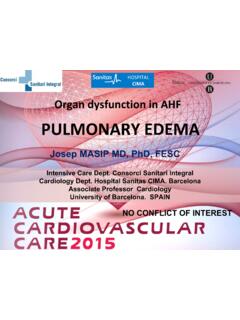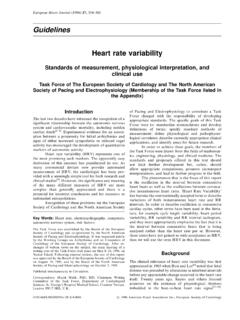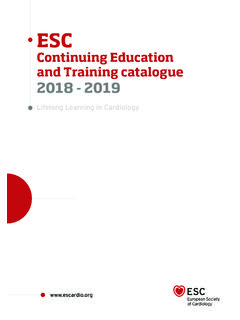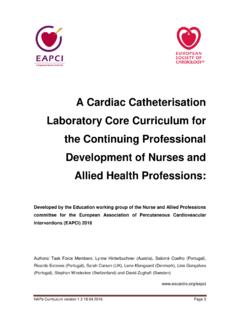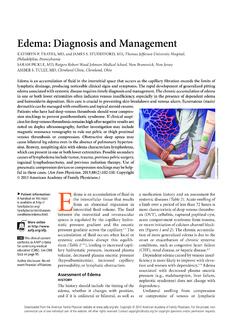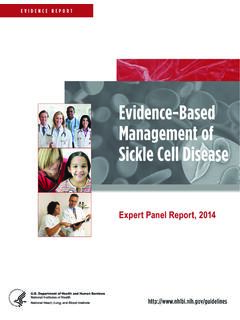Transcription of ESC/EAS Guidelines for the management of dyslipidemias
1 ESC/EAS GUIDELINESESC/EAS Guidelines for the managementof dyslipidaemiasThe Task Force for the management of dyslipidaemias of theEuropean Society of Cardiology (ESC) and the EuropeanAtherosclerosis Society (EAS)Developed with the special contribution of: European Association for CardiovascularPrevention & Rehabilitation Authors/Task Force Members: Z eljko Reiner*(ESC Chairperson) (Croatia)Alberico L. Catapano*(EAS Chairperson)*(Italy), Guy De Backer (Belgium),Ian Graham (Ireland), Marja-Riitta Taskinen (Finland), Olov Wiklund (Sweden),Stefan Agewall (Norway), Eduardo Alegria (Spain), M. John Chapman (France),Paul Durrington (UK), Serap Erdine (Turkey), Julian Halcox (UK), Richard Hobbs(UK), John Kjekshus (Norway), Pasquale Perrone Filardi (Italy), Gabriele Riccardi(Italy), Robert F. Storey (UK), David Wood (UK).ESC Committee for Practice Guidelines (CPG) 2008 2010 and 2010 2012 Committees: Jeroen Bax (CPG Chairperson2010 2012), (The Netherlands), Alec Vahanian (CPG Chairperson 2008 2010) (France), Angelo Auricchio (Switzerland),Helmut Baumgartner (Germany), Claudio Ceconi (Italy), Veronica Dean (France), Christi Deaton (UK), Robert Fagard(Belgium), Gerasimos Filippatos (Greece), Christian Funck-Brentano (France), David Hasdai (Israel), Richard Hobbs (UK),Arno Hoes (The Netherlands), Peter Kearney (Ireland), Juhani Knuuti (Finland), Philippe Kolh (Belgium),Theresa McDonagh (UK), Cyril Moulin (France), Don Poldermans (The Netherlands), Bogdan A.
2 Popescu (Romania),Z eljko Reiner (Croatia), Udo Sechtem (Germany), Per Anton Sirnes (Norway), Michal Tendera (Poland), Adam Torbicki(Poland), Panos Vardas (Greece), Petr Widimsky (Czech Republic), Stephan Windecker (Switzerland)Document Reviewers:, Christian Funck-Brentano (CPG Review Coordinator) (France), Don Poldermans (Co-ReviewCoordinator) (The Netherlands), Guy Berkenboom (Belgium), Jacqueline De Graaf (The Netherlands), Olivier Descamps(Belgium), Nina Gotcheva (Bulgaria), Kathryn Griffith (UK), Guido Francesco Guida (Italy), Sadi Gulec (Turkey),Yaakov Henkin (Israel), Kurt Huber (Austria), Y. Antero Kesaniemi (Finland), John Lekakis (Greece), Athanasios J. Manolis(Greece), Pedro Marques-Vidal (Switzerland), Luis Masana (Spain), John McMurray (UK), Miguel Mendes (Portugal),Zurab Pagava (Georgia), Terje Pedersen (Norway), Eva Prescott (Denmark), Quite ria Rato (Portugal), Giuseppe Rosano(Italy), Susana Sans (Spain), Anton Stalenhoef (The Netherlands), Lale Tokgozoglu (Turkey), Margus Viigimaa (Estonia),M.
3 E. Wittekoek (The Netherlands), Jose Luis Zamorano (Spain).*Corresponding authors: Z eljko Reiner (ESC Chairperson), University Hospital Center Zagreb, School of Medicine, University of Zagreb, Salata 2, 10 000 Zagreb, Croatia. Tel:+385 1 492 0019, Fax:+385 1 481 8457, Alberico L. Catapano (EAS Chairperson), Department of Pharmacological Science, University of Milan,Via Balzaretti, 9, 20133 Milano, Italy. Tel:+39 02 5031 8302, Fax:+39 02 5031 8386, Other ESC entities having participated in the development of this document:Associations: Heart failure Groups: Cardiovascular Pharmacology and Drug Therapy, Hypertension and the Heart, : Cardiology Practice, Primary Cardiovascular Care, Cardiovascular content of these European Society of Cardiology (ESC) and the European Atherosclerosis Society (EAS) Guidelines has been published for personal and educational use only. Nocommercial use is authorized. No part of the ESC Guidelines may be translated or reproduced in any form without written permission from the ESC.
4 Permission can be obtained uponsubmission of a written request to Oxford University Press, the publisher of theEuropean Heart Journaland the party authorized to handle such permissions on behalf of the ESC Guidelines represent the views of the ESC and the EAS, were arrived at after careful consideration of the available evidence at the time they were professionals are encouraged to take them fully into account when exercising their clinical judgement. The Guidelines do not, however, override the individual responsibility ofhealth professionals to make appropriate decisions in the circumstances of the individual patients, in consultation with that patient, and where appropriate and necessary the patient sguardian or carer. It is also the health professional s responsibility to verify the rules and regulations applicable to drugs and devices at the time of The European Society of Cardiology and the European Atherosclerosis Association. All rights reserved.
5 For permissions please email: Heart Journal (2011)32, 1769 1818 disclosure forms of the authors and reviewers are available on the ESC Cholesterol Triglycerides Treatment Cardiovascular diseases GuidelinesTable of Contents1. Preamble ..17722. Introduction .. Scope of the problem .. Dyslipidaemias ..17733 Total cardiovascular risk .. Total cardiovascular risk estimation .. Risk levels ..17784. Evaluation of laboratory lipid and apolipoprotein parameters ..17795. Treatment targets ..17836. Lifestyle modifications to improve the plasma lipid profile .. The influence of lifestyle on total cholesterol andlow-density lipoprotein-cholesterol levels .. The influence of lifestyle on triglyceride levels .. The influence of lifestyle on high-densitylipoprotein-cholesterol levels .. Dietary supplements and functional foods active onplasma lipid values .. Lifestyle recommendations ..17877. Drugs for treatment of hypercholesterolaemia.
6 Statins .. Bile acid sequestrants .. Cholesterol absorption inhibitors .. Nicotinic acid .. Drug combinations .. Statins and bile acid sequestrants .. Statins and cholesterol absorption inhibitors .. Other combinations .. Low-density lipoprotein apheresis .. Future perspectives ..17938. Drugs for treatment of hypertriglyceridaemia .. management of hypertriglyceridaemia .. Fibrates .. Nicotinic acid .. fatty acids .. Drug combinations .. Statins and fibrates .. Statins and nicotinic acid .. Statins andn-3 fatty acids ..17969. Drugs affecting high-density lipoprotein .. Statins .. Fibrates .. Nicotinic acid .. Cholesterylester transfer protein inhibitors .. Future perspectives ..179710. management of dyslipidaemias in different clinical settings .. Familial dyslipidaemias .. Familial combined hyperlipidaemia .. Familial hypercholesterolaemia .. Familial dysbetalipoproteinaemia .. Familial lipoprotein lipase deficiency.
7 Other genetic disorders of lipoproteinmetabolism .. Children .. Women .. The elderly .. Metabolic syndrome and diabetes .. Patients with acute coronary syndrome and patientsundergoing percutaneous coronary intervention .. failure and valvular disease .. Autoimmune diseases .. Renal disease .. Transplantation patients .. Peripheral arterial disease .. Stroke .. Human immunodeficiency virus patients ..180911. Monitoring of lipids and enzymes in patients onlipid-lowering drug therapy ..181012. How to improve adherence to lifestyle changes andcompliance with drug therapy ..181113. References ..1812 Addenda on the ESC website:Addendum I. SCORE charts with high-densitylipoprotein-cholesterolAdden dum II. Practical approach to reach low-densitylipoprotein-cholesterol goalAddendum III. Inhibitors and inducers of enzymatic pathwaysinvolved in statin metabolismAddendum IV. Additional referencesESC/EAS Guidelines1770 Abbreviations and acronyms4 DDie Deutsche Diabetes Dialyse Studie4 SScandinavian Simvastatin Survival StudyABC-1 ATP-binding cassette transporter 1 ACCORDA ction to Control Cardiovascular Risk inDiabetesACSacute coronary syndromeAIM-HIGHA therothrombosis Intervention in Metabolicsyndrome with Low HDL-C/High Triglycerideand Impact on Global Health OutcomesALTalanine aminotransferaseapo (a)apolipoprotein (a)apo A1apolipoprotein A1apo Bapolipoprotein Bapo Eapolipoprotein Eapo Capolipoprotein CARBITER-6 HALTSA rterial Biology for the Investigation of theTreatment Effects of Reducing Cholesterol 6:HDL and LDL Treatment Strategies inAtherosclerosisARMYDAA torvastatin for Reduction of MyocardialDamage During AngioplastyASSIGNCV risk estimation model from the ScottishIntercollegiate Guidelines NetworkAURORAA study to evaluate the Use of Rosuvastatin insubjects On Regular haemodialysis.
8 An Assess-ment of survival and cardiovascular eventsBIPB ezafibrate Infarction PreventionBMIbody mass indexCABG coronary artery bypass graftCADcoronary artery diseaseCAREC holesterol and Recurrent EventsCETP cholesterylester transfer proteinCIconfidence intervalCIMT carotid intima media thicknessCKcreatine phosphokinaseCKDchronic kidney diseaseCORONACO ntrolled ROsuvastatin multiNAtional studyin heart failureCPGESC Committee for Practice GuidelinesCTTC holesterol Treatment Trialists CollaborationCVcardiovascularCVDcardiova scular diseaseCYPcytochrome P450 isoenzymeDal-OUTCOMES Dalcetrapib Outcomes trialDALY sdisability-adjusted life yearsDHAdocosahexaenoid acidDGAT-2diacylglycerol acyltransferase-2 EASE uropean Atherosclerosis SocietyEMEAE uropean Medicines AgencyEPAeicosapentaenoic acidERextended release formESCE uropean Society of CardiologyESRDend-stage renal diseaseFATSF amilial Atherosclerosis Treatment StudyFCHfamilial combined hyperlipidaemiaFDAFood and Drug AdministrationFHfamilial hypercholesterolaemiaFIELDF enofibrate Intervention and Event Loweringin DiabetesGFRglomerular filtration rateGISSI-HFGruppo Italiano per lo Studio della Sopravvi-venza nell Infarto Miocardico-Effect of rosu-vastatin in patients with chronic Heart FailureGISSI-PGruppo Italiano per lo Studio della Sopravvi-venza nell Infarto Miocardico-PrevenzioneGPgeneral practitionerGPRG protein-coupled receptorHAART highly active antiretroviral treatmentHATSHDL-Atherosclerosis Treatment StudyHbA1cglycated haemoglobinHDLhigh-density lipoproteinHDL-Chigh-density lipoprotein-cholesterolHeFHheterozygous familial hypercholesterolaemiaHFheart failureHHSH elsinki Heart StudyHIVhuman immunodeficiency virusHMG-CoAhydroxymethylglutaryl coenzyme AHoFHhomozygous familial hypercholesterolaemiaHPSH eart Protection StudyHPS2-THRIVEH eart Protection Study 2 Treatment of HDLto Reduce the Incidence of Vascular
9 Eventshs-CRPhigh sensitivity C-reactive proteinHTGhypertriglyceridaemiaICDI nternational Classification of DiseasesIDLintermediate-density lipoproteinILLUMINATEI nvestigation of Lipid Levels management toUnderstand its Impact in AtheroscleroticEventsJUPITERJ ustification for the Use of Statins in PrimaryPrevention: an Intervention Trial EvaluatingRosuvastatin StudyLCAT lecithin-cholesterol acyltransferaseLDLlow-density lipoproteinLDLRlow-density lipoprotein receptorLDL-Clow-density lipoprotein-cholesterolLp(a)lipoprotein( a)LPLlipoprotein lipaseMetSmetabolic syndromeMImyocardial infarctionMTPmicrosomal transfer proteinMUFA monounsaturated fatty acidNICEN ational Institute for Health and ClinicalExcellenceNNTnumber needed to treatNon-HDL-Cnon-HDL-cholesterolNYHANew York Heart AssociationPADperipheral arterial diseasePCIpercutaneous coronary interventionPCSK9proprotein convertase subtilisin/Kexin 9 ESC/EAS Guidelines1771 PPAR peroxisome proliferator-activated receptorPPPP ravastatin Pooling ProjectPROCAMP rospective Cardiovascular Munster studyPROSPERP rospective Study of Pravastatin in the Elderlyat RiskPROVE-ITPravastatin or Atorvastatin Evaluation andInfection TherapyPUFA polyunsaturated fatty acidRAAS systemrenin angiotensin aldosterone systemRCTrandomized controlled trialREVEALR andomized Evaluation of the Effects ofAnacetrapib Through Lipid-modificationRRRrelative risk reductionRYRred yeast riceSCORES ystematic Coronary Risk EstimationSEASS imvastatin and
10 Ezetimibe in Aortic StenosisSFAsaturated fatty acidsSHARPS tudy of Heart And Renal ProtectionSLEsystemic lupus erythematosusTCtotal cholesterolTGtriglycerideTIAtransient ischaemic attackTNTT reating to New Targets TrialTRLtriglyceride-rich lipoproteinULNupper limit of normalUSF 1upstream transcription factor 1VA-HITV eterans Affairs High-density lipoproteinIntervention TrialVLDL very low density lipoproteinVLDL-Cvery low density lipoprotein-cholesterolWHOW orld Health OrganizationConversion factorsmg/dL cholesterol mmol/L triglycerides mmol/L glucose mmol/L 181. PreambleGuidelines summarize and evaluate all available evidence at thetime of the writing process on a particular issue with the aim ofassisting physicians in selecting the best management strategiesfor an individual patient, with a given condition, taking intoaccount the impact on outcome, as well as the risk benefit ratioof particular diagnostic or therapeutic means. Guidelines are nosubstitutes but are complements for textbooks and cover theESC Core Curriculum topics.




